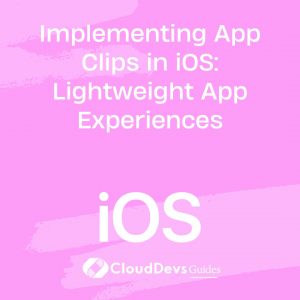Implementing App Clips in iOS: Lightweight App Experiences
In the fast-paced world of mobile applications, user experience is paramount. With the advent of iOS 14, Apple introduced a revolutionary feature called App Clips, aiming to streamline user interactions by providing lightweight app experiences without the need for full app installations. In this post, we’ll delve into what App Clips are, how they work, and provide examples of their implementation.
What are App Clips?
App Clips are small parts of your app that focus on a specific task and are discoverable at the moment they are needed. They provide a quick and seamless way for users to access a specific functionality of your app without downloading and installing the full application. App Clips are designed to be lightweight, fast to launch, and can be accessed through various channels such as NFC tags, QR codes, Safari, or Messages.
How do App Clips Work?
When a user encounters an App Clip, they can launch it instantly by scanning a QR code, tapping an NFC tag, or clicking a link in Safari. The App Clip runs in a compact form, providing only the necessary features and information relevant to the user’s immediate needs. Users can interact with the App Clip, complete their task, and seamlessly transition back to their previous activity without any interruptions.
Examples of Implementing App Clips
- Food Ordering: Imagine you’re walking down the street and craving a quick bite to eat. You come across a restaurant with an NFC tag on the menu. By tapping your phone on the tag, you instantly launch the restaurant’s App Clip, allowing you to browse the menu, place an order, and pay for your meal, all without downloading the full restaurant app. Learn more about NFC technology
- Parking Payment: You’re in a rush to attend a meeting downtown but need to find parking quickly. As you approach a parking meter, you notice a QR code sticker. Scanning the QR code with your phone opens the parking app’s App Clip, enabling you to pay for parking right from your phone without installing the full app. Explore QR code usage in iOS apps
- Event Ticketing: You receive an invitation to a concert from a friend via iMessage. The message includes a link to the event ticketing App Clip. With a single tap, you launch the App Clip, purchase your ticket, and add it to your Apple Wallet, all within seconds. Integrate iMessage with your app
Benefits of App Clips
- Improved User Experience: App Clips provide a frictionless way for users to access specific app functionality without the hassle of downloading and installing the full application.
- Increased Discoverability: By leveraging various channels such as NFC tags, QR codes, and Messages, App Clips make it easier for users to discover and interact with your app.
- Faster Transactions: App Clips streamline tasks such as ordering food, paying for parking, or purchasing event tickets, saving users time and effort.
- Reduced Clutter: Since App Clips are lightweight and temporary, they don’t clutter the user’s device with unnecessary apps, enhancing device storage and organization.
Conclusion
With the introduction of App Clips in iOS 14, Apple has redefined the way users interact with mobile applications. By providing lightweight and contextual app experiences, App Clips offer a seamless solution for quick tasks and transactions. Whether it’s ordering food, paying for parking, or purchasing event tickets, App Clips empower users to accomplish tasks swiftly and efficiently, ultimately enhancing the overall mobile experience.
Embrace the future of mobile interactions with App Clips and revolutionize the way your users engage with your app.
So, what are you waiting for? Dive into the world of App Clips and elevate your app experience to new heights!
Table of Contents









